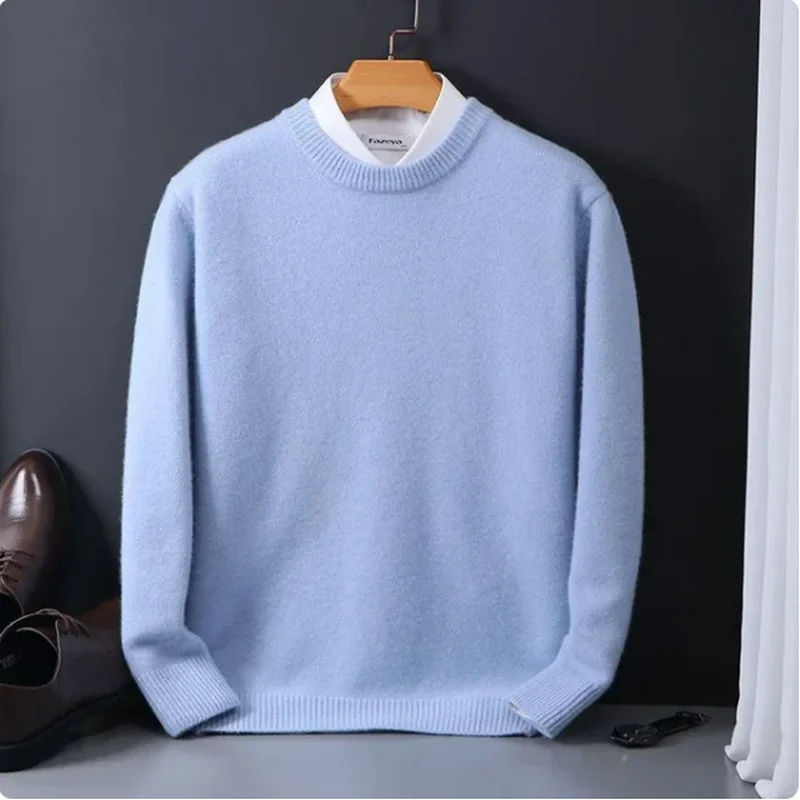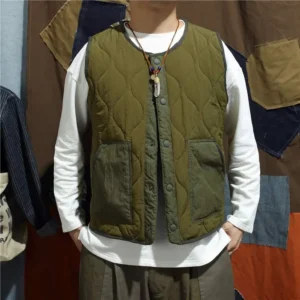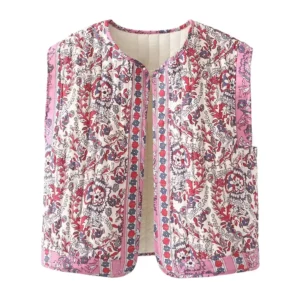Introduction
Yes, cashmere absolutely can be worn year-round! While many people associate this luxurious fabric exclusively with winter wardrobes, this common misconception overlooks cashmere’s remarkable natural versatility. The secret lies in cashmere’s unique fiber structure and exceptional properties that make it suitable for all four seasons, not just the coldest months.
Premium cashmere, particularly the high-grade fibers used in Estate Cloth garments, offers temperature-regulating properties that provide warmth when needed while remaining breathable in warmer conditions. This remarkable adaptability means your favorite cashmere pieces don’t need to hibernate during spring and summer months.
In this guide, you’ll discover how different weights, weaves, and styles of cashmere can transition seamlessly through seasons, along with practical styling tips for year-round wear. We’ll explore everything from lightweight summer options to transitional pieces that work across multiple seasons.
The journey to year-round cashmere outfit ideas begins with understanding what makes this extraordinary fiber so adaptable. When you invest in quality cashmere pieces, you’re actually expanding your wardrobe’s versatility rather than limiting it to a single season. The finest versatile cashmere pieces for all seasons offer both practical benefits and timeless elegance that transcends seasonal boundaries.
The Science Behind Cashmere’s Year-Round Versatility
What makes cashmere so uniquely suited for year-round wear? The answer lies in the remarkable natural structure of cashmere fibers. Unlike ordinary wool or synthetic materials, cashmere fibers have a hollow core and natural crimp that create exceptional properties:
- Exceptional insulation: The hollow fiber core traps warm air close to the body in cold weather
- Superior breathability: These same fibers allow excess heat and moisture to escape in warm conditions
- Moisture management: Cashmere can absorb moisture up to 35% of its weight without feeling damp
- Lightweight warmth: Provides 3-8 times more insulation than regular wool at a fraction of the weight
- Natural temperature regulation: Automatically adjusts to your body temperature
This unique combination makes cashmere fundamentally different from other luxury fibers. While traditional wool can feel scratchy and retain too much heat for warm weather, and cotton often loses shape and provides little insulation, cashmere maintains its structure while adapting to your body’s needs.
The finest cashmere, like that used in premium garments, features fibers under 16 microns in diameter—thinner than a human hair. This extraordinary fineness contributes to its lightweight feel against the skin while maintaining impressive durability when properly cared for.
Understanding the cashmere gauge, warmth, and quality relationship helps explain why this material performs so well across seasons. The natural properties of cashmere fibers create a built-in climate control system that few other materials can match, making it genuinely suitable for year-round comfort.
Understanding Summer-Weight Cashmere
When most people think of cashmere, they picture thick, heavy sweaters. However, cashmere actually comes in various weights and knit structures specifically designed for different seasons and temperatures. Understanding these variations is key to building a truly year-round cashmere wardrobe.
Gauge Explained
The term “gauge” refers to the number of needles per inch used to knit the fabric—a crucial factor in determining how lightweight and breathable the final garment will be. Higher gauge numbers create finer, lighter knits perfect for warmer weather.
| Gauge Number | Best For | Characteristics |
|---|---|---|
| 5-7 gauge | Deep winter | Heavy, chunky knits for maximum warmth |
| 8-10 gauge | Cool weather | Medium weight for transitional seasons |
| 12-14 gauge | Spring, fall, indoor wear | Lightweight with good drape |
| 16-18+ gauge | Summer, warm climates | Ultra-fine, highly breathable |
When shopping for summer cashmere, look for items labeled as “high-gauge” or with specific numbers like “14-gauge” or higher. These indicate the lightweight, breathable construction ideal for warmer temperatures. The difference between a 7-gauge winter sweater and an 18-gauge summer piece is immediately noticeable both visually and in how the garment feels against your skin.
Ply-Count and Its Importance
Ply refers to the number of yarn strands twisted together to create the thread used in knitting. This factor significantly impacts how a cashmere garment performs in different temperatures:
Single-ply: Made from one strand of yarn, creating exceptionally lightweight, drapey garments perfect for summer wear. Single-ply typically weighs about 30% less than comparable two-ply items.
Two-ply: The most versatile option, providing a balance between durability and lightweight comfort. Ideal for year-round wear in most climates.
Multi-ply (3+ ply): Creates sturdier, warmer garments best suited for colder months. These heavier constructions provide maximum insulation but may be too warm for summer wear.
For warm weather, single-ply and lightweight two-ply options offer the ideal balance of luxury and comfort without overheating.
Weaves and Knits for Maximum Breathability
Beyond gauge and ply, the specific pattern used to knit or weave cashmere significantly impacts its breathability. Summer-appropriate cashmere often features:
- Open-stitch patterns that allow air circulation
- Looser knit structures that create natural ventilation
- Pointelle details that enhance breathability while adding visual interest
- Basket weaves that create texture while maintaining airflow
These construction techniques make summer cashmere delightfully light and airy, often described as “whisper-thin” or “featherweight.” When assessing summer cashmere, you should be able to see some light through the knit when held up—a sign of the appropriate openness for warm weather.
Cashmere Blends for Enhanced Warm-Weather Comfort
While pure cashmere offers remarkable versatility, blending cashmere with other premium fibers can enhance specific properties for warm-weather wear. These thoughtfully created blends combine cashmere’s natural benefits with complementary characteristics from other luxury materials.
| Blend Type | Benefits | Best For |
|---|---|---|
| Cashmere-Silk | Enhanced drape, cooling touch, subtle sheen | Evening wear, dressy occasions |
| Cashmere-Cotton | Improved structure, enhanced durability, casual feel | Everyday wear, t-shirts, casual tops |
| Cashmere-Linen | Maximum breathability, textural interest, cooling properties | Hot climates, summer garments |
| Cashmere-Tencel | Moisture-wicking, smooth hand-feel, sustainable option | Active lifestyles, travel wear |
The ideal blend percentage depends on your needs. For maintaining luxury while gaining warm-weather benefits, look for blends with at least 30-50% cashmere content. This ensures you still enjoy cashmere’s signature softness while benefiting from the complementary fiber’s properties.
Cashmere-silk blends excel in elegant summer settings, with silk’s natural cooling properties enhancing cashmere’s breathability while adding a subtle luster. For more casual summer wear, cashmere-cotton blends offer improved structure and durability while maintaining exceptional comfort.
Our cashmere wool cardigans demonstrate how thoughtful blending can create garments that transition beautifully between seasons, offering the perfect balance of comfort and practicality.

Your Year-Round Cashmere Wardrobe: Seasonal Garment Guide
Building a truly year-round cashmere collection means selecting pieces specifically designed for each season’s unique requirements. With the right selections, you can enjoy cashmere’s luxury and comfort no matter the temperature outside.
Spring Cashmere Essentials
Spring’s variable temperatures make it perfect for lightweight cashmere pieces that offer versatility and layering options:
- Lightweight open-front cardigans (12-14 gauge) that can be easily removed as temperatures rise
- Fine-knit V-neck pullovers that work well under light jackets or on their own
- Cashmere wraps and scarves to protect against cool mornings and evenings
- Sleeveless cashmere shells that layer beautifully under blazers or cardigans
The key to spring cashmere is versatility. Look for pieces in mid-range gauges (12-14) that offer enough warmth for cooler days but won’t overwhelm when temperatures rise. Spring cashmere layering techniques focus on creating adaptable outfits that can be adjusted throughout the day as conditions change.
Summer Cashmere Options
Yes, summer cashmere exists! These ultra-lightweight pieces offer unexpected luxury for warm weather:
- Whisper-thin cashmere t-shirts and tank tops (16-18+ gauge)
- Single-ply cashmere camisoles for elegant evening wear
- Lightweight cashmere wraps for air-conditioned environments
- Open-knit cashmere cardigans for cool summer evenings
- Cashmere-silk blend shorts or lightweight skirts
Summer cashmere works best in high gauges (16+) with open weaves that maximize breathability. The focus is on creating pieces so light they feel almost weightless against the skin. These items are particularly valuable for travel, as they take up minimal space while offering comfort across various environments.
Exploring year-round luxury cashmere reveals how these summer-weight pieces can become unexpected warm-weather favorites, offering a touch of luxury without overheating.

Fall Transition Pieces
Fall’s fluctuating temperatures make it ideal for medium-weight cashmere that offers adaptable warmth:
- Mid-gauge (10-12) pullovers and sweaters
- Cashmere ponchos and wraps that add warmth without bulk
- Layering pieces like thin turtlenecks that work under jackets or blazers
- Two-ply cardigans that provide versatile warmth
Fall cashmere excels in rich, saturated colors that complement the season while offering practical warmth. These pieces bridge your summer and winter wardrobes, often becoming the most frequently worn items in your cashmere collection due to their versatility.
Winter Cashmere (Brief Overview)
Winter represents cashmere’s traditional season, where its exceptional warmth-to-weight ratio truly shines:
- Heavy-gauge (5-8) sweaters and cardigans for maximum insulation
- Cable-knit and textured patterns that trap additional warm air
- Full-length cashmere coats and accessories for elegant warmth
- Multi-ply construction for durability and insulation
While winter cashmere follows the familiar pattern most people associate with this luxury fiber, these pieces form just one part of a comprehensive year-round cashmere wardrobe. Our collection of cashmere sweaters includes options for every season, demonstrating the remarkable versatility of this premium material.
Cashmere Wrap Sweaters, Women's Cashmere Pullovers
$75.89 Select options This product has multiple variants. The options may be chosen on the product pageCashmere Cable Knit Sweaters, Women's Cashmere Pullovers
Price range: $111.82 through $112.93 Select options This product has multiple variants. The options may be chosen on the product page- Price range: $171.47 through $181.33 Select options This product has multiple variants. The options may be chosen on the product page
Cropped Cashmere Sweaters, Women's Cashmere Pullovers
$155.77 Select options This product has multiple variants. The options may be chosen on the product page- Price range: $87.29 through $91.47 Select options This product has multiple variants. The options may be chosen on the product page
Oversized Cashmere Sweaters, Plus Size Cashmere Sweaters, Women's V-Neck Cashmere Sweaters
$136.87 Select options This product has multiple variants. The options may be chosen on the product page
Styling Cashmere for Warmer Climates and Transitional Seasons
Incorporating cashmere into warm-weather wardrobes requires thoughtful styling approaches that maximize comfort while maintaining elegance. The right techniques transform cashmere from a winter-only luxury to a year-round essential.
Layering Techniques for Maximum Versatility
Strategic layering allows cashmere to adapt to changing temperatures throughout the day:
- Start with ultra-thin cashmere layers close to the body
- Add or remove lightweight cashmere pieces as needed
- Use cashmere cardigans as elegant “indoor jackets” for air-conditioned spaces
- Incorporate cashmere accessories to add luxury to lightweight outfits
The beauty of fine cashmere is its ability to layer without adding bulk. A lightweight cashmere t-shirt under a blazer offers invisible warmth that won’t distort your silhouette, while a cashmere wrap can transform a simple outfit when temperatures drop in the evening.
Learning how to wear cashmere in unpredictable weather helps you navigate transitional seasons with confidence and style.

Pairing with Summer Fabrics
Cashmere pairs beautifully with traditional warm-weather fabrics, creating unexpectedly harmonious combinations:
- Cashmere with linen: Contrasting textures create visual interest while both fabrics offer temperature regulation
- Cashmere with lightweight cotton: The structure of cotton balances cashmere’s drape
- Cashmere with silk: Complementary luxury fibers that enhance each other’s natural sheen
- Cashmere with seasonal prints: Solid cashmere pieces anchor bolder summer patterns
These combinations work because lightweight cashmere shares many properties with traditional summer fabrics—breathability, moisture management, and natural fibers that feel comfortable against the skin. Our cashmere vests offer perfect layering options that complement these summer fabric pairings.
Color and Fit Considerations
Adapting cashmere for year-round wear involves thoughtful color and fit choices:
- Lighter, brighter colors reflect summer’s palette while darker tones work year-round
- Looser fits enhance airflow for warmer conditions
- Slightly oversized styles allow for layering without bulk
- Cropped or three-quarter length sleeves adapt traditional styles for warmer weather
Summer cashmere often features relaxed silhouettes that maximize breathability while maintaining elegant drape. These pieces look intentionally designed for warm weather rather than simply being winter items worn out of season.
Caring for Your Year-Round Cashmere Investment
Proper care ensures your cashmere remains beautiful across all seasons. Lightweight summer cashmere requires particularly attentive maintenance to preserve its delicate structure:
- Hand wash using lukewarm water and gentle cashmere shampoo
- Support delicate pieces during washing to prevent stretching
- Avoid wringing—instead, press water out gently between towels
- Dry flat on a clean towel away from direct sunlight or heat
- Store folded with acid-free tissue in breathable containers
- Use gentle de-pilling tools specifically designed for fine-gauge cashmere
Lightweight cashmere may require more frequent gentle de-pilling than heavier pieces, as the finer yarns can be more susceptible to surface abrasion. However, proper care actually becomes easier in warmer months as items typically need less intensive cleaning than winter pieces exposed to heavy outerwear and scarves.
For detailed guidance on maintaining your investment pieces, our resource on machine washing cashmere provides specific instructions for safely cleaning even your most delicate items.
Frequently Asked Questions About Year-Round Cashmere
Is cashmere truly breathable in hot weather?
Yes, high-quality lightweight cashmere is genuinely breathable in warm conditions. Its natural moisture-wicking properties help regulate body temperature by drawing perspiration away from the skin. The hollow core structure of cashmere fibers allows air circulation that keeps you feeling fresh even in warmer environments. While extremely hot and humid conditions might still call for even lighter fabrics, quality cashmere in appropriate weights performs surprisingly well in moderate summer temperatures.
What’s the difference between winter and summer cashmere?
The primary differences lie in weight, construction, and knit density. Summer cashmere typically features higher gauge numbers (16+), single-ply construction, and more open knit patterns that enhance breathability. Winter cashmere uses lower gauge numbers (5-8), multiple plies, and denser knit structures that maximize warmth retention. Summer pieces might weigh 30-50% less than their winter counterparts while maintaining cashmere’s signature softness and drape.
Will wearing cashmere in summer make me sweat?
Quality lightweight cashmere actually helps manage moisture better than many synthetic “summer” fabrics. Its natural moisture-wicking properties draw perspiration away from the body, while its breathable structure allows air circulation. For maximum comfort, choose loose-fitting, high-gauge cashmere in single-ply construction, and opt for open-knit patterns that enhance ventilation. Cashmere-silk or cashmere-linen blends can offer additional cooling properties for particularly warm conditions.
How do I choose the right cashmere for summer?
Look for these key indicators when selecting summer-appropriate cashmere:
- High gauge numbers (16+) indicating fine, lightweight knitting
- Single-ply construction for minimum weight
- Open or loose knit patterns that allow airflow
- Light colors that reflect rather than absorb heat
- Relaxed silhouettes that don’t cling to the body
- Cashmere-silk or cashmere-linen blends for enhanced breathability
When examining potential purchases, hold the fabric up to light—summer cashmere should have a degree of translucence indicating its lightweight nature.
Is lightweight cashmere durable?
While lightweight cashmere requires more careful handling than heavier varieties, high-quality fine-gauge cashmere can be surprisingly durable when properly maintained. The key factors affecting durability are the original fiber quality and proper care routines. Premium cashmere made from longer fibers will maintain its beauty longer, even in lightweight constructions. Regular gentle care, proper storage, and prompt attention to any pilling will help summer cashmere remain beautiful for many seasons.
For more seasonal outfit ideas using cashmere, explore our full collection of year-round cashmere pieces designed to provide luxury, comfort, and versatility in every season.







